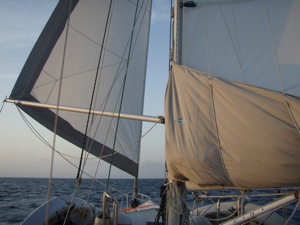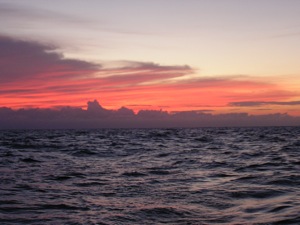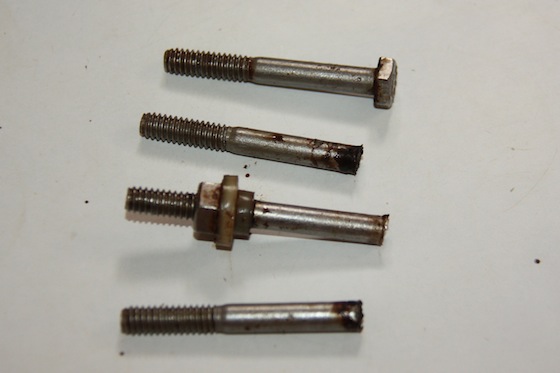I love sailing at night … relaxing in the cockpit, the night skies dance in their brilliance, reminiscent of a brilliantly lit Christmas tree. My mind wanders as Orion dances across the sky acting as my own personal clock … every 15 minutes, I scan the horizon for 360 degrees to see if anything dares intrude into my reverie. During the day, dolphins play in our bow wake – sometimes for an hour or more. Sunset brings another opportunity to view a fabulous, but rare, green flash. After dark, the sudden noise of a dolphin spouting lures me out of the mesmerizing shimmering light show of tiny phosphorescent unknown creatures gliding alongside in the sea. Sunrise is always spectacular accompanied by the aroma of hot fresh coffee and the adventures of another day.
Of course, it wasn’t always relaxing (and don’t get me wrong, sometimes it’s still not!) … our first overnights were challenging – not because the sailing was challenging, but because we were inexperienced. Even now after sailing from Annapolis to Cartagena, Columbia, and back many overnights later, an overnight still requires special preparation … and there’s no guarantee that we’ll be well rested the next morning. But better preparation usually results in more enjoyable sails. Here are some standard items in our checklist:
- Determine your ideal weather window: wind 10-12, waves 3-5 or less, preferably from some other direction but on the nose. We plan overnight passages well in advance, first checking with pilot charts to see what the best time of year is for making the passage.
- Float Plan? Find a buddy boat to sail with and enjoy planning the sail over dinner. Discuss how far apart you’ll sail and if you’ll maintain VHF radio contact on a set schedule. It’s always a good idea to set a check in schedule with an SSB friend not going with you. Check in at set intervals on two different frequencies 5 minutes apart just in case propagation prevents you from hearing each other on the initial frequency. We usually like a 6 PM and midnight check in. In the morning, we check in to the closest SSB net – the Northwest Caribbean Net or Southwest Caribbean Net.
- Set your watch schedule – we prefer 3 hour watches, some like 4, we know those that do 2. The key is to get on your watch schedule as soon as possible – whiling away daytime hours watching the sparkling water, insures missing out on the sleep needed to feel rested the next morning. Ask your doctor if you have trouble falling asleep … we sometimes take an Advil and a Benedryl or maybe a Tylenol PM to help us fall asleep. Ear plugs and a dark mask help to keep out the extraneous noise … you need to be able to hear sharp loud noises, like your on-watch partner’s yell, but at the same time dull the monotonous squeak in the mast keeping you awake!
- Plan and prepare food ahead of time so if the ride is bumpy or if one of the crew gets seasick from going below, you won’t go hungry. I always prepare meals that are easily re-heated, but have contingency foods – boiled eggs, cheese and crackers, snacks and drinks available to be consumed in the cockpit without waking the off watch person. Be sure to position these snacks already in the cockpit or close at hand. We usually plan to eat a hot dinner together in the cockpit each evening between watch changes just to have some semblance of a “regular” schedule. Hot meals are a big bonus to crew morale, especially when everyone’s tired, so be sure to plan accordingly.
- Seasickness medication. Even if you don’t get seasick, when the sun goes down and the visible horizon becomes invisible, people react differently, so be prepared. It is our belief that everyone gets seasick, it’s merely a function of finding what makes you react adversely. For my husband, it’s the smell of the diesel fumes blowing into the cockpit when motorsailing. For me, it’s crazy confused seas that pitch the boat like a tilta-whirl. I have yet to identify the precise motion, but somehow my stomach has no trouble! We usually use Meclazine because we don’t have to take it until we feel bad, but then have to endure 20 minutes of hell until it kicks in. We also have ginger capsules and scop patches aboard if we want a variation. Be SURE to keep the seasickness meds somewhere where you do not have to go below to access them! Ours are in the top rack of the spice rack within reach of the companionway. And be cognizant that most seasickness medications require you take them well in advance to setting sail.
- Before departing, we get the boat ready for an overnight. One of the primary causes of diesel malfunction is clogged filters. Before departing, we clean the fuel and tanks so that bouncing around won’t cause gunk in the bottom of the tanks to cause problems. Lifelines are put in place, the dinghy is secured with racheting straps, navigation lights are tested, other on deck equipment is more adequately tied on, anything on deck that can be stowed below is, the Monitor windvane blade is put in place, a walk around the deck and visual inspection of the rigging helps insure no unwanted incidents underway. Down below, we rattleproof everything we can anticipate might clank, disturbing sleep underway. Prime suspects are lockers with dishes, pots and pans and especially canned foot storage. Paper towels between pots and pans, dishes and mugs help immensely. We also double check all the boat’s known idiosyncrasies – our alternator belt slips, so we make sure it’s tight, our throttle cable has come loose, so we check it every time. Little things don’t create big problems if they go right! Just before departing, we put out the binoculars, cockpit mike for the VHF, helm GPS and turn on the laptop and have the Passport Nobeltec charts up and running on the nav desk below.
- We log our progress hourly on an overnight sail which means getting our log book ready and the category headers prepared ahead of time (we don’t use a ready made log book). Our category headers are: Latitude & Longitude, Wind Speed & Direction, Boat Speed & Direction, Weather (i.e. clear, cloudy, stars, moon, squalls, etc), Barometric Pressure and General Comments. Since we have duplicate electronic charts running (Garmin Blue Charts as well as Nobeltec Passport Charts), we don’t usually manally plot our position on the paper chart, but before we had redundant electronic charts, we always plotted the position on the paper chart, ready to view at a glance.
- Prepare the ditch bag just in case. We use an extra large waterproof bag that lives on the quarterberth at the base of the companionway stairs, directly under the EPIRB. In case of emergency, it would be close at hand and easy to grab. The biggest difficulty is determining what items go in since we use a lot of them underway. We solved the dilemma by taping a list of other items to be added in an emergency to the top of the nav desk nearby. In the stress of an emergency, we might not remember the necessary items to grab.
- Prepare our place to sleep. We use a side settee to sleep underway, rigging a leecloth to insure we don’t fall out on starboard tack. We find the earplugs and darkening facemask and the pillows and sheets and get it all ready before departing.
- Underway after one last triplecheck of the weather forecast, we don our lifejacket suspenders and if there’s any question, we rig our tethers to the lifelines. Anytime underway if someone has to leave the cockpit, tethers are required unless it’s daytime and absolutely flat seas. At night, the rule is no leaving the cockpit for any reason without the other person on deck.
- Just after departing, tie off anchor and chain so they can’t become loose and bounce around in a seaway potentially damaging the boat – some boats remove them and stow them below, especially for longer passages.
- After all is settled and we’re underway, we rig our trolling pole. Remember that if you fish, you must always anticipate what you will do when you catch a fish! After being caught offguard and clueless the first time our pole went ZZzzinnnggg, we now know that to turn the boat into the wind slightly to slow progress while David grabs the pole and starts playing the fish. When it becomes visible, we turn on the autopilot long enough to check what kind of fish we have in our Sportfishing book, then prepare to haul it aboard (or remove the hook & let it go). We haven’t had the fortune (or misfortune) of catching really large fish, so we generally put them in our oversize cooler until we can deal with them later.
- Murphy’s Law requires that if the weather is going to be contrary, it will do so after dark (or at midnight, depending on your experience). Our rule is to reef the sails at least one level lower than what we sailed with all day long – if it turns out to be a quiet night it’s no big deal to shake the reefs out, but it’s not fun to go forward in pitching seas that can suddenly transform out of nowhere. If we’ve been running under the spinnaker or wing on wing, the spinnaker or pole comes down before dark.
- Consider attaching a wristwatch to the steering handrail – we set ours to beeps every hour on the hour to remind us to stop whatever we’re doing and take a fix and weather readings. I also like to use my kitchen timer in the cockpit if I’m reading or writing to remind me to look around every 15 minutes – We calculate that’s the time a freighter might take from the horizon to be too close for us to adequately alter course if necessary.
- Make sure the lights on instruments are set for night – i.e. red lights, not white lights to impair night vision. Test to make sure your running lights are working before it gets dark and place an extra flashlight – or spotlight in the cockpit to shine on your sails if you doubt another boat sees you and doesn’t respond via the radio. We also make sure our headlamps are on our heads and functioning correctly.
- Since we don’t have AIS aboard, we leave radar on at night to double check area traffic (put an X on another boat and check to see if it’s position relative to your boat changes to see if it will cross you astern or ahead) and also to keep track of any squall activity.
A key mistake by many novice overnighters is sticking too close to your plan. Make a plan, including headings and distance, but once underway, if conditions warrant, don’t be afraid to deviate from the plan. A perfect example is when we left the Dry Tortugas for a two night sail to Isla Mujeres, Mexico. The day started off glorious, but when we approached the edge of the gulf stream, the seas kicked up and we encountered training squalls, one after the other. Our buddy boat altered course and traversed the gulf stream at a 90 degree angle – not only providing more comfortable sailing, but getting them across and out of the squalls in time to allow a comfortable night’s rest and a languid sail with the dolphins the next morning. In contrast, we got no sleep with one squall after another and were utterly exhausted by the time we exited the gulf stream. In retrospect, when they called to tell us they were altering course, we should have joined them instead of being so adamant about sailing our pre-planned course. Our course wasn’t wrong, but our trip could have been so much more comfortable had we just been a bit more flexible!

Remember to plan your sail so that you arrive in good light. Never enter an unfamiliar anchorage or harbor in the dark unless it’s a serious emergency. If you happen to make good time and arrive ahead of daylight, even though you may be tired, sail lazy circles until it is light enough to enter. While monitoring your progress underway with hourly logs, you may choose to shorten sail or otherwise slow the boat if you see you’ll arrive too early.
The final, and most important point … you can always change your mind. If you leave and two hours out, the seas and winds are not what were forecast, turn around, return to safe harbor and wait for a better weather window.
Happy sailing!
What do you do to prepare for an overnight? Everyone does it differently, share your experience!














